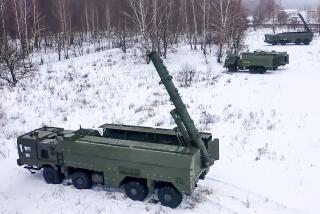Today’s Game Is Brinkmanship, Not Nuclear War
- Share via
Brinkmanship--deliberately going to the brink to make some strategic gain without actually going to war.
During the Cold War it was a standard diplomatic tactic used by both the United States and the Soviet Union. It happened over Berlin several times, over Cuba in 1962 and over the Middle East in 1973. Each time, these brinkmanship crises frightened the world before ending without a shot being fired.
Now that both India and Pakistan have nuclear weapons, they too are trying their hand at brinkmanship. But can they avoid a slide into war? They share a hot border in Kashmir where there is shooting every day, a dangerous complication that American and Soviet leaders never had to face.
India wants to persuade Pakistan to abandon its post-1989 policy of supporting armed movements that operate inside the Indian part of Kashmir and have staged attacks deep within India, including the Dec. 13 attack on the Indian Parliament that threatened to decapitate the Indian government and even in failure killed 14 people.
Until 1989, the violence in Indian Kashmir was confined to small groups of local Muslims who were fighting for Kashmir’s independence. One reason why Pakistan’s well-funded Inter-Services Intelligence, or ISI, started sponsoring armed Islamic militants in 1989 was to displace the original Kashmir independence movement with one seeking to join Pakistan. As an army general, Pakistani President Pervez Musharraf was a leading proponent of sending Islamic militants to fight in Kashmir--not because he favored Islamic terrorism but as a way of outmaneuvering both India’s military superiority and the nuclear checkmate.
News reports continue to focus on two small organizations, the Jaish-e-Mohammed and Lashkar-e-Taiba, because both have been implicated in the Dec. 13 attack. Actually, even before the present crisis, the Pakistani government was unhappy with the Jaish and the Lashkar, because their leaders were talking of an independent Islamic state in Kashmir and because their super-extremism frightened even the ISI. It was therefore not much of a sacrifice for Musharraf to cut off support for the two organizations and to order the detention of their chiefs.
But the Indians are demanding that Pakistan also cut off all the other fighting organizations including Hezb-ul-Moujahedeen, which is the armed wing of the Jamaat-i-Islami, the most important Islamic party in Pakistan.
In speeches, Musharraf is preparing Pakistanis for more action against Islamic extremism in general, but so far he has refused to shut down all the organizations; that would amount to giving up the fight for Kashmir.
Musharraf also has refused to hand over for trial those whom India identified as responsible for the Dec. 13 attack absent more “convincing evidence.”
Meanwhile, the Indian army and navy are mobilizing. The most dramatic Indian move has been the forward deployment of a missile group, with 12 launchers for short-range ballistic missiles, supposedly armed with nuclear warheads. The Pakistanis have responded by mobilizing their Chinese-made M-11 missiles, which are also are supposedly armed with nuclear warheads.
Yet the best evidence that India is engaged in brinkmanship rather than actually preparing for war is that little is being done to keep preparations secret.
It also is significant that Lal Krishna Advani, India’s minister of home affairs, was in Washington last week, and that Defense Minister George Fernandes was there this week. If the Indians were planning a war, both certainly would have remained home.
Before the nuclear age, attempts at brinkmanship often failed because governments lost control of public opinion, which insisted on greater victories--or smaller defeats--than diplomacy could achieve. The Indian and Pakistani governments are constrained by public opinion, Musharraf perhaps more so because he has weakened his Islamic credentials by cooperating with the United States against the Taliban.
Therefore there is terrible danger that the two governments will talk themselves into a war, unable to step back because of the pressure of their public opinion. Another danger is a spontaneous outbreak. Shooting incidents are common along the Line of Control in Kashmir, and now there are many more troops within rifle range of one another.
So far, both Musharraf and Indian Prime Minister Atal Behari Vajpayee have been playing a cool diplomatic game centered on Washington; both are hoping for more U.S. support as the crisis continues. So long as each remains in control of his own side, the crisis can be kept under control.
As head of a center-right coalition seen as tough on Kashmir and Pakistan, Vajpayee is fairly safe from parliamentary pressures to escalate the crisis.
But because he has abruptly changed Pakistan’s policy from the encouragement and physical support of extremism in both Afghanistan and Pakistan, Musharraf is vulnerable. If he were to be overthrown by coup d’etat or eliminated by assassination, the world could be faced with a nuclear crisis.
More to Read
Sign up for Essential California
The most important California stories and recommendations in your inbox every morning.
You may occasionally receive promotional content from the Los Angeles Times.













